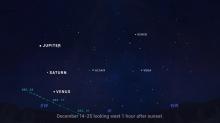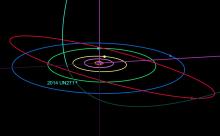Listen to today's episode of StarDate on the web the same day it airs in high-quality streaming audio without any extra ads or announcements. Choose a $8 one-month pass, or listen every day for a year for just $30.
You are here
Comet NeoWise
A comet that defied the odds is in view in the evening sky. It’s fairly bright, although you need binoculars to get the best view.
Comet C/2020 F3 NeoWise was discovered on March 27th by a NASA spacecraft. The comet passed closest to the Sun on July 3rd — about 27 million miles. Many comets disintegrate during such close passes. In fact, that’s what happened to two comets that were forecast to become naked-eye objects earlier this year. But NeoWise survived.
The Sun’s heat vaporized some of the ice at the surface of the comet. The gas boiled away into space. That freed small grains of rock and dirt, which flew away as well. The Sun’s light and magnetic field sculpt the dust into a long, glowing tail, and the gas into a shorter tail.
The comet’s closest approach to Earth is about 64 million miles, so it’s no threat to our planet.
NeoWise will be on display in the second half of July and into August. It’ll be in the northwest as darkness falls, passing below and then beside the Big Dipper. It may be visible to the unaided eye, but you’ll probably need binoculars to see its tail. The view will be better from the northern states, where the comet will pass a little higher across the sky and remain in view most of the night.
NeoWise will disappear from sight in a few weeks as it moves away from the Sun. And you won’t get another chance to see it — it won’t return to the inner solar system for almost 6800 years.
Script by Damond Benningfield






